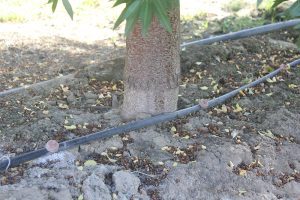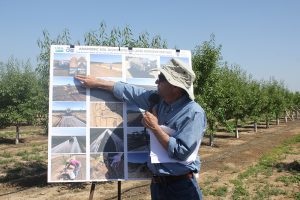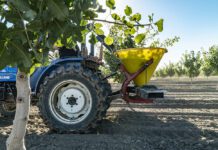
Whole orchard recycling (WOR) has many proven benefits to trees and orchard soils, but it doesn’t appear to have positive, or negative, impacts on replant disease problem in almonds, according to recent trials.
Prunus replant disease (PRD) is a soilborne disease complex that suppresses early growth and affects cumulative yield in replanted almond orchards. At the Almond Replant Field Day at UC’s Kearney Research and Education Center, results of trials conducted to determine alternatives to soil fumigation for management of PRD were presented. While WOR has many proven benefits to orchard health, researchers are continuing to refine nitrogen management and strategies to reduce Phytophthora, a soilborne fungal disease, in newly planted almond orchards.
The trials were done to see how WOR may impact almond replant problems and other diseases. Almond planted after almond or other stone fruits without effective preplant soil fumigation may exhibit growth suppression in the first few years after replanting, resulting in delayed yield capacity. Prunus replant disease has been found to result in part from negative effects from the previous orchard on soil microbial communities.
Prunus replant disease can occur with or without significant populations of phytopathogenic nematodes. Compared to PRD, phytopathogenic nematodes, another “replant problem,” tend to impact orchards later after PRD effects have diminished. But root damage from nematode feeding can persist over the economic life of orchards.
Greg Browne, USDA research plant pathologist at UC Davis, reports that as much as one-third of California’s almond and stone fruit acreage is infested with potentially debilitating plant parasitic nematodes, and even more of the land is impacted by Prunus replant disease.

Without remediation, you can anticipate moderate growth suppression, Browne said. This soilborne complex is a biological phenomenon in the bacterial realm, Browne added, but it is not known if the soil bacterium association is causal or if the disease is in the compromised roots. Prunus replant disease has a front-end impact, but gradually tails off after several years. In the Kearney trials, trees in fumigated plots over the first three years had a significant yield advantage by the third harvest over trees in non-fumigated plots.
Whole orchard recycling plus pre-plant fumigation resulted in increased growth over trees planted in non-fumigated sites. Walking the rows of the trials showed significant differences in tree sizes in fumigated and non-fumigated plots. Browne said WOR has subtle effects on tree performance but it does not prevent PRD (it also does not aggravate the disease.) Increased trunk size was the most notable tree response with pre-plant fumigation.
Browne noted there is potential for biological treatments for PRD, but they are not yet there. Anerobic soil disinfestation is one possible alternative to fumigation. Anaerobic soil disinfestation (ASD) is a process of disinfesting the soil by creating anaerobic soil conditions with the incorporation of a carbon soil amendment, tarping and irrigating to saturation to begin a two- to six-week treatment period.
One of the trials compared the use of rice bran with almond hulls, and it also tested different N and P fertilizer regimes and tarping versus not tarping. The trials compared rice bran with almond hulls as amendments alone and as ASD drivers with different N and P regimes.
Browne said the ASD strategy that proved most effective in terms of tree growth was rice bran, water and tarping. Rice bran alone was also effective, but he noted rice bran quantities were limited while almond hulls were more plentiful.
Vigorous rootstocks are another avenue to overcoming PRD, Browne said.

Phytophthora
Crown and root rot Phytophthora, and Perennial Phytophthora canker are also issues in young orchards after replanting. The crown and root rot are linked to wet conditions. Canker is a scion disease that affects trees, typically in the 5-6 leaf.
Phytophthora, known as a waterborne pathogen, thrives in wet conditions and is a part of a group of fungi called oomycetes. In wet conditions, Phytophthora can produce swimming zoospores that can infect plants. The species can also persist in dry conditions in soil. Soil fumigation can reduce but not eliminate populations of these organisms. Phytophthora can also be introduced in an orchard site by nursery stock.
Management of Phytophthora root and crown rot begins with cultural practices. Mohammad Yaghmour, UCCE orchard systems advisor in Kern County, noted that water management and planting on berms are both good strategies when replanting on an orchard site with a history of Phytophthora root and crown rot. He noted during his presentation at the Almond Replant Field Day that in recent years in Kern County as well as in counties to the north, many farm calls have involved Phytophthora crown and root rot of newly planted almond orchards as well as those a few years older.
Drip lines left too long near the base of young trees were noted as a possible cause in crown and root rots. While it is necessary to place them close to the trees at planting, when the root system becomes more established, the lines should be moved further away from the trees.
Rootstock selection can also play a part in preventing crown and root rot infection. Yaghmour said that Mariana 2624, a plum hybrid is the most resistant compared to other rootstocks. He also noted peach/almond hybrid rootstocks are more susceptible to Phytophthora compared to Nemaguard and Lovell.
Yaghmour advised prevention of the canker disease in the form of tree training. The most common site of the cankers is in ‘pockets’ that form where several scaffold branches join the trunk in close proximity. Less common are infections near joints of two scaffold branches.
To avoid potential problems with infection sites, Yaghmour said careful scaffold selection and wider spacing can keep likely infection sites from forming.
Chemical treatment for Phytophthora includes use of mefenoxam or phosphonates. Yaghmour said preventative foliar sprays with phosphonate in the fall or spring suppressed development of cankers for up to five months after treatment. Mean canker lengths on trees sprayed with phosphonate before inoculation were smaller than those on untreated trees.
Yaghmour said the fungicide Oxathiapiprolin (Orondis) is a new tool that can be used to manage Phytophthora in almonds.











